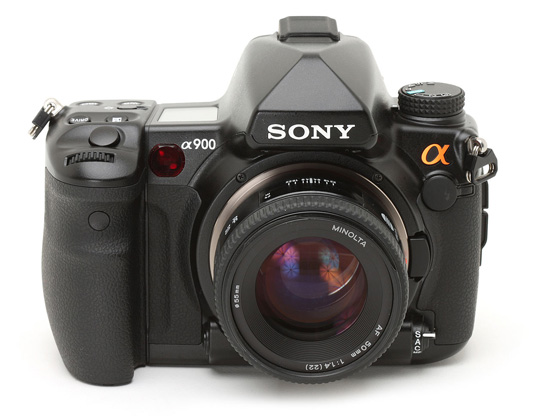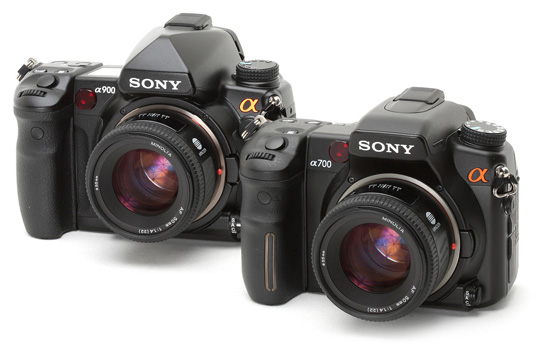 In the cut-throat digital camera market it’s increasingly unusual for products to be shown in prototype form or announced more than a matter of weeks before they hit the stores. There’s several reasons for the manufacturers’ habit of playing their cards so close to their chests, not least that they can’t afford to harm sales of the models they’ve already released. Sony, the newest ‘new kid’ on the DLSR block, has no such worries, this being its first proper ‘high end’ DSLR.
In the cut-throat digital camera market it’s increasingly unusual for products to be shown in prototype form or announced more than a matter of weeks before they hit the stores. There’s several reasons for the manufacturers’ habit of playing their cards so close to their chests, not least that they can’t afford to harm sales of the models they’ve already released. Sony, the newest ‘new kid’ on the DLSR block, has no such worries, this being its first proper ‘high end’ DSLR.
In fact, if anything the pressure was on the company to show it was committed to becoming a major SLR system player and that it wasn’t going to squander Minolta’s long legacy in this market after picking up the assets Konica Minolta shed when it pulled out of the photography market. Thus we saw the first prototype of the Alpha 900 – Sony’s flagship full frame digital SLR – back in early 2007 (it appeared behind glass at trade shows such as PMA in March 07), and information has been trickling out ever since; most significantly with the announcement in January of this year of a 35mm full frame CMOS sensor.
Review based on a production Alpha DSLR-A900
And so when Sony finally showed the finished Alpha 900 to us back in the late summer there were few surprises at the basic specification or the appearance of the camera. As we started to dig a little deeper, pore over the fine print and actually use the Alpha 900 we were, however, increasingly surprised – and almost always pleasantly so – at some of the decisions made by Sony’s engineers when designing its flagship SLR.
The success of the Alpha 900 amongst the Minolta, Konica Minolta and Sony faithful seems assured; at a launch price of just shy of $3000 it offers a lot of ‘bang for your buck’ and there is undoubtedly a significant number of Minolta film SLR users who’ve been waiting years for a full frame digital body on which to use their existing lenses. The challenge for Sony, however, is to generate some interest from people without an existing investment in the Minolta (or subsequent Alpha) system. And on paper the Alpha 900 looks promising – and we’re already impressed with the build, handling and viewfinder, so let’s find out how well the latest addition to the small but growing ‘full frame club’ performs.
Key features
- 24.6 MP 35mm format full-frame CMOS sensor (highest res in class)
- SteadyShot INSIDE full frame image sensor shift stabilization (world first)
- High Speed Dual Bionz processors
- Eye-level glass Penta-prism OVF, 100% coverage, 0.74x magnification
- 9 point AF with 10 assist points, center dual-cross AF w/2.8 sensor
- 5 frames per second burst, newly developed mirror box
- Intelligent Preview Function
- 3 User programmable custom memory modes on mode dial
- Advanced Dynamic Range Optimizer (5 step selectable)
- 40 segment honeycomb metering
- 3.0″ 921K pixel Photo Quality (270 dpi) LCD display, 100% coverage
- Direct HDMI output
- ISO 200-3200 (ISO 100-6400 expanded range)
- User interchangeable focusing screens (3 options)
- CF Type I/II and MS slots, LI-ION battery, STAMINA 880 shots
- Weight 850g (without battery, card, accs)
- New Image Data Converter SR software (includes vignetting control)
- New Vertical Grip
- Supplied with wireless remote control
- Magnesium Alloy body and rubber seals for dust and moisture resistance
- AF micro adjustment
- $2999.99 body price; available late October 2008
Compared to Alpha 700 – key differences
As someone who has used the Alpha 700 extensively I was immediately struck by just how similar its new big brother is; the basic design and layout is almost identical, as are the user interface and the core feature set. Unlike Canon and Nikon, who tend to add further differentiation to their professional products with swathes of extra features and (especially) custom function options, Sony has gone for almost total consistency between the A700 and A900.
Obviously there are some pretty significant differences both physically and functionally (some of which are upgrades we’d expect to see in the Alpha 700’s eventual replacement); aside from the obvious (sensor size/resolution) the key changes are:
- Dual Bionz processors (A700 only has one)
- Three custom modes on mode dial in place of A700’s scene modes
- All magnesium alloy construction
- New 9 point AF with 10 assist points for Wide AF mode
- 100% viewfinder coverage (A700 is 95%)
- Improved noise reduction options (including ‘off’)
- Improved D-Range Optimizer auto function
- No grip sensor or built-in flash
- Top LCD info panel
- Intelligent Preview Mode
- Increased pixel pitch due to improvements in sensor design
 Sony Alpha A900 |
 Sony Alpha A700 |
|
| Body material | • Magnesium Alloy Chassis and exterior • Environmental seals |
• Aluminum chassis • Magnesium Alloy body shell • high grade plastic exterior • Environmental seals |
| Sensor | • 35.9 x 24.0 mm CMOS sensor ‘Exmor’ • RGB Color Filter Array • Built-in fixed low-pass filter • 25.7 million total pixels • 24.6 million effective pixels • On-chip Column A/D Conversion & NR |
• 23.5 x 15.6 mm CMOS sensor ‘Exmor’ • RGB Color Filter Array • Built-in fixed low-pass filter • 13.05 million total pixels • 12.25 million effective pixels • On-chip Column A/D Conversion & NR |
| Processor | Dual Bionz | Bionz |
| Crop Factor | 1x | 1.5x |
| Image sizes (3:2) | • 6048 x 4032 (24M 3:2) • 4400 x 2936 (13M 3:2) • 3024 x 2016 (6.1M 3:2) • 3924 x 2656 (11M APSC) • 2896 x 1928 (5.6M APSC) • 1984 x 1320 (2.6M APSC) |
• 4288 x 2856 (L RAW) • 4272 x 2848 (L) • 3104 x 2064 (M) • 2128 x 1424 (S) |
| Auto Focus | • TTL CCD line sensors (9-points, center dual cross types + 10 assist sensors) | • TTL CCD line sensors (11-points, 10 lines with center dual cross sensor) |
| Custom modes | Three | Three |
| Bracketing | • Single or continuous bracketing • 3 or 5 frames • 0.3, 0.5 , 0.7 or 2.0 EV steps (2.0 EV steps for 3 exposures only) |
• Single or continuous bracketing • 3 or 5 frames • 0.3, 0.5 or 0.7 EV steps |
| Continuous | • H: Approx 5fps max • L: Approx 3fps max • RAW: Up to 12 frames • cRAW (compressed): Up to 25 frames • RAW+JPEG: Up to 10 frames • JPEG (XFINE): Up to 11 frames • JPEG (STD/FINE): 285/105 |
• H: Approx 5fps max • L: Approx 3fps max • RAW: Up to 18 frames • cRAW (compressed): Up to 25 frames • RAW+JPEG: Up to 12 frames • JPEG (XFINE): Up to 16 frames • JPEG (STD/FINE): Unlimited (to card capacity) |
| Viewfinder | • Optical glass pentaprism • Spherical Acute Matte focusing screen (interchangeable) • Frame coverage approx 100% • Magnification approx. 0.74x • Eye-relief 20 mm from eyepiece, 21 mm from frame • Eyepiece shutter |
• Optical glass pentaprism • Spherical Acute Matte focusing screen (interchangeable) • Frame coverage approx 95% • Magnification approx. 0.9x • Eye-relief 25 mm from eyepiece, 21 mm from frame |
| Vertical Grip | Optional vertical Grip VG-C90AM | Optional vertical Grip VG-C70AM |
| Dimensions | 156 x 117 x 82 mm | 141.7 x 104.8 x 79.7 mm |
| Weight | • No battery: 850 g • With battery: 895 g |
• No battery: 690 g • With battery: 768 g |
| Other | • Intelligent Preview mode • New raw converter software • AF Micro Adjustment • Top LCD panel |
• Grip sensor • Built in flash • Scene modes |
![]()
If you’re new to digital photography you may wish to read the Digital Photography Glossary before diving into this article (it may help you understand some of the terms used).
|
Conclusion / Recommendation / Ratings are based on the opinion of the reviewer, you should read the ENTIRE review before coming to your own conclusions. Images which can be viewed at a larger size have a small magnifying glass icon in the bottom right corner of the image, clicking on the image will display a larger (typically VGA) image in a new window. To navigate the review simply use the next / previous page buttons, to jump to a particular section either pick the section from the drop down or select it from the navigation bar at the top. DPReview calibrate their monitors using Color Vision OptiCal at the (fairly well accepted) PC normal gamma 2.2, this means that on our monitors we can make out the difference between all of the (computer generated) grayscale blocks below. We recommend to make the most of this review you should be able to see the difference (at least) between X,Y and Z and ideally A,B and C. |
This article is Copyright 2008 Dpreview.com and the review in part or in whole may NOT be reproduced in any electronic or printed medium without prior permission from the author. For information on reproducing any part of this review (or any images) please contact: Phil Askey
Source: Digital Photography Review


